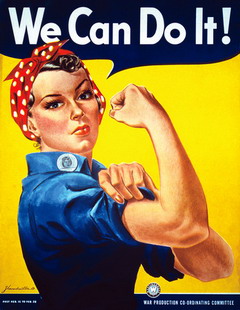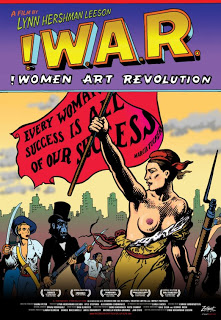“The way I watch movies, I’m really searching for myself because I don’t get to see enough of myself and I don’t, I kind of don’t get to like myself enough. But if I can see myself on-screen then I know I exist.”
Tag: Feminist Art Movement
Documentary Review: !Women Art Revolution
So why don’t we know more women in art? It’s a case of omission, of erasing women and their contributions out of history. A stunning film 40 years in the making, “!Women Art Revolution” seeks to fill that gap by combining “intimate” interviews along with visceral visual images of paintings, performance art, installation art, murals and photography.
!Women Art Revolution showcases the controversy swirling around The Dinner Party, Judy Chicago’s infamous exhibit. A powerful feminist installation piece, it consists of a massive triangular-shaped banquet table with 39 place settings. Each plate, utensils, chalice and placemat decorated with colors and iconography unique for the intended guests: various famous women throughout history and myth. Chicago created a groundbreaking piece that puts women front and center, something often lacking in the media. Apparently, The Dinner Party caused the government unease and even outrage. Accused of being pornographic due to the butterfly and floral plates symbolizing the vulva, the U.S.House debated on whether or not it should be displayed. Yes, because vaginas are soooo scary. Some Representatives, all male, said it wasn’t art. Um, who are they to determine that?! One Congressman, a former Black Panther, defended the piece saying it was art and protected as free speech. Sadly, the House passed a bill banning it from being exhibited (Oh that’s right, because Congress has nothing better to do! Sigh). Luckily, when it went to the Senate, a small group of wealthy and influential women urged their Senators to drop the legislation, causing it to be dismissed.
The film covers and interviews the Guerilla Girls, an anonymous watchdog group of gorilla mask-wearing feminist activists combating sexism in the international art world. Formed in 1985, an exhibit at the Museum of Modern Art that showcased an international collection of recent artists in painting and sculpture spurred their creation. The exhibit featured 169 artists, only 3 of whom were women. They also looked at the collections in the Metropolitan Museum of Art in 1989 and found that only 3% of the artists in the modern wing were women and 83% of nude subjects were women. This prompted their famous poster tagline, “Do women have to be naked to get into the Met. Museum?” The Guerilla Girls protest and continue to speak out, publishing report cards on gender and racial gaps in other museums, galleries and exhibits. They force the art world to face the reality of its own discrimination.
!Women Art Revolution easily could have become dull with dry facts or depressing due to the obstacles the female artists struggled against. Yet it pulses and throbs with fervent energy. Like a little feminist sponge, I soaked up all of the passion, activism and information. With images of women, hearing women’s voices and a score composed by Carrie Brownstein, Sleater-Kinney guitarist and Portlandia actor, the film feels like a safe haven for feminists. In our male-dominated media, it was inspiring to see a riveting documentary created by women and featuring women. My only complaint of the film is that it doesn’t really follow a chronological or thematic order, making it feel a bit chaotic. Yet it also makes it feel raw and personal. Interestingly, Hershman Leeson, almost prophetically anticipating this, admits as much in her own chronology, comprised of various pieces knitted together “like a patchwork quilt.” I found it refreshing that Hershman Leeson’s introspection as a documentary filmmaker leads her to question whether or not she should feature her own art in the film. She comes to the rightful conclusion that she should as women have been omitted from art history for too long.
“Of course I think it has positive connotations for intelligent women and men. But there is still an existing fear of the word itself, as well as miscommunicated baggage of what it represents. This needs revision. Feminism is about cultural values and equality. The young women I am in contact with are grateful to learn about this history. They devour the information. It is, after all, their legacy.”
It is this legacy to future generations that means so much to Hershman Leeson. Arising from the documentary, she started the RAW/WAR project, a virtual community allowing people to submit images of drawings, paintings, performances, dance and music, opening up the dialogue of art and gender to a global community. Also, all of the interview transcripts and many of the videos are available online. As to the message of the film, Hershman Leeson declares:
“As Marcia Tucker reminds us, “humor is the single most important weapon we have!” I think audiences will be inspired by the courage, sense of humor and tenaciousness of the artists who courageously and constantly reinvented themselves and in doing so dynamically revised existing exclusionary policies of their culture.”
Art questions, challenges and inspires. While it can be beautiful and serene, it can also be disturbing and uncomfortable, unnerving the viewer, forcing the audience to look at the world around them. The art in this documentary reveals the media’s incessant agenda of writing women out of history. Society views women’s art, their experiences and stories, as lesser than men’s: less important, less noble, less substantial. When I took Art History in college, I remember we only studied a handful of female artists. The Feminist Art Movement is a chapter ripped out of history, a period most people just don’t know. Whether you’re an art aficionado or not, you simply must see and experience this revolutionary and visionary film for yourself. !Women Art Revolution reclaims women’s narratives and manifests a vocal group of dissenters rattling the cages of constriction and conformity, refusing to be silenced.





